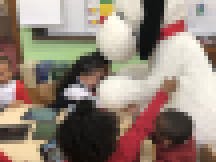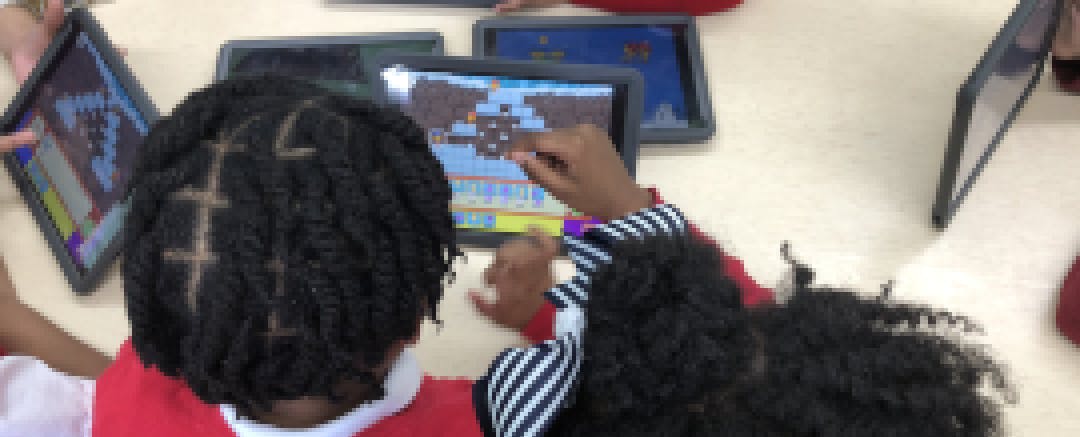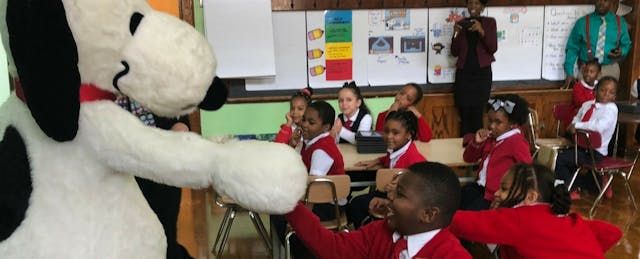Educators around the country this week are celebrating the Hour of Code, an international effort to bring awareness to computer science. But at Emma L. Johnston Elementary school (P.S. 241) in Brooklyn, students use words like “algorithm” and “loops” year-round—and with remarkable ease. Their teacher has an unlikely strategy to get them to that level of understanding: unplugging the tech.
“Ms. Silva taught us how to code, and Snoopy doesn’t have fingers, so we taught him how to code,” says first-grader Chloe Mcphatter about a Peanuts-themed program character in a coding game her class uses called Snoopy’s Snow Brawl. Throughout her school this week there are balloons and colorful signs on the walls. Her teachers also invited Snoopy, a giant costumed character from their game, into the classroom.

“Ms. Silva also taught us algorithms, and she gave us our passcodes. I want to teach coding too when I grow up,” Mcphatter explains with excitement.
With about 90 percent of school’s 524 students on free and reduced lunch, P.S. 241 contrasts sharply with the wealthy computer science schools in places such as Palo Alto. Yet the students here can quickly break down complex computer science terminology that most adults would struggle with.
In an effort to bring equitable opportunities to public school students in the district, Mayor Bill de Blasio’s administration has enrolled 23 elementary schools into a special program within the city’s Computer Science for All initiative. The program, known as the Software Engineering Program Junior (SEPjr), is designed to work with K-5th grade students using computer-based and “unplugged” activities to teach foundational computer science concepts. The pilot is in its second year, and some students already seem to have a firm grasp on computer science topics.
“We start students as early as Kindergarten, focusing more on the fundamentals to make sure they actually have what it takes to make it in the upper grades,” says Jessica Silva, the school’s computer science teacher.
Silva has been teaching at the elementary-level for 17 years, but this is only her second year as a computer science instructor—a subject she had no previous background in. Yet, after a year of training to help prepare her for the new role, she says she has seen real advancements in her ability to teach the new subject, as well as her students’ proficiency in computer science.

A somewhat ironic but crucial part of her strategy in teaching the language of computer science is “unplugging,” meaning shutting down computers and tablets to do hands-on activities.
“These lessons require students to work cutting and pasting and directional movements. We do a lot of unplugged activities; then we transfer that knowledge into the computer-based activities,” Silva explains.
Silva describes an algorithm as something that happens step-by-step with directions. To get students to grasp the concept, she instructs them to “program” her to do a particular dance move, step-by-step.
“When you transfer that instruction into coding, you think, ‘how do you give the character directions? What should he do now? What are the steps?’ from beginning to end,” Silva explains. “We start off really small and then when we get to the actually logistical pieces we try to connect it all.”
Building a strong computer science foundation, like that exhibited by Silva’s students, takes a lot of iteration. She is constantly seeking feedback from kids and often tries to find ways that students can use the complex vocabulary in their daily activities.

For instance, she will ask students to think of everyday activities like making a sandwich as a formula that requires algorithmic steps. “I try to connect it to their real life. Then they are able to process it, and the vocabulary comes easier to them,” Silva says.
Some might be surprised to know that students using this type of extensive vocabulary do not actually code. When I went visit them for their Hour of Code event, they were playing a codeSpark Academy game called Snoopy’s Snow Brawl. A game where Charlie Brown's pet dog, Snoopy, and his yellow Beagle Scouts competitively travel up a snow pyramid using interactive directional arrows. The game is meant to introduce students to the concept of sequencing, loops, and parameters—but not necessarily teach them professional languages like Python.

“It's a very slow introduction to coding. Its applicable to all children doing the basics of coding,” Silva says.
Both Silva and New York City Department of Education administrator, Wladimir Lewis-Thomas, notes that expanding the program to the entire school has had a significant impact on the way the students perceive computer science. Unlike past generations who might have viewed the topic as intimidating and exclusive, students at P.S. 241 who spoke with EdSurge seem excited about it.
“The kids see it as an opportunity to play games, but as adults we know it's more than that,” says Lewis-Thomas. “It’s really learning the functions of life, and teaching them the importance of understanding what’s behind the game.”


